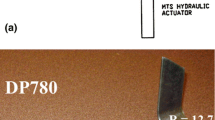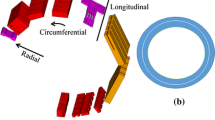Abstract
A comparison was made between tensile (mode I) and shear (mode II) fracture characteristics in high strength aluminium alloys (7075-T6 and 6061-T651) using a relatively new mode II fracture specimen to evaluate the critical stress intensity factor. The enlarged plastic zone during mode II fracture required that an increased specimen thickness be used for determining K Hc under a purely plane strain condition. Plane stress conditions prevailed in the mode II fracture of 7075-T6 with a specimen thickness less than 10 mm, while plane strain controlled mode II fracture at a thickness of 10 mm or greater. Fractographic analysis revealed a distinctive difference in the micromechanisms responsible for crack extension. Small dimples were observed only on the mode II fracture surfaces, resulting from a microvoid nucleation fracture mechanism. The mode I fracture surfaces showed a mixed distribution of dimple sizes resulting from a void growth fracture mechanism. Comparing the critical stress intensity factors, the shear mode of failure exhibited a substantially higher value than the tensile mode, resulting from the effect of the sign and magnitude of the hydrostatic stress state on the microvoid nucleation event. Zero hydrostatic tension in the mode II loading configuration helps delay microvoid nucleation, increasing the apparent toughness. The high hydrostatic tension resulting from a mode I loading configuration enhances microvoid nucleation which promotes crack propagation at relatively lower stress intensity factors.
Similar content being viewed by others
References
J.E. Campbell, W.E. Berry and C.E. Feddersen, Damage Tolerant Design Handbook, MCIC-HB-01, Sept. 1973.
O.A. Onyenwuenyi, Scripta Metallurgica 18 (1984) 455–458.
R.C. Bates, in Metallurgical Treatises, J.K. Tien and J.F. Elliot (eds.), American Institute of Metallurgical Engineers, New York (1981).
R.A. Everett Jr., Effect of Service Usage on Tensile, Fatigue, and Fracture Properties of 7075-T6 and 7178-T6 Aluminum Alloys, Report NASA TM X-3165, Langley Research Center, Hampton, VA (1975).
F.G. Nelson, and J.G. Kaufman, Plane Strain Fracture Toughness of Aluminum Alloys at Room and Subzero Temperatures, ASTM STP 496, Philadelphia, PA (1971).
R.J. Buzzard, B. Gross and J.E. Srawley, Mode II Fatigue Crack Growth Specimen, Report NASA TM 83722, Lewis Research Center, Cleveland, OH (1984).
N. Iosipescu, Journal of Materials 2 no. 3 (1967) 537–566.
H.A. Richard, International Journal of Fracture 17 (1981) R105-R107.
D.L. Jones and D.B. Chisholm, Engineering Fracture Mechanics 7 (1975) 261–270.
K.R. Raju, International Journal of Fracture 17 (1981) R193-R197.
J. Watkins, International Journal of Fracture 23 (1983) R135-R138.
M. Arcan, Z. Hasin and A. Voloshin, Experimental Mechanics 18 (1978) 141–146.
R.J. Buzzard, Experimental Compliance Calibration of the NASA Lewis Research Center Mode II Fatigue Specimen, Report NASA TM 86908, Lewis Research Center, Cleveland, OH (1985).
W.F. Brown, Jr., and J.E. Srawley, Plane Strain Crack Toughness Testing of Metallic Materials, ASTM STP 410, Philadelphia, PA (1967).
ASTM Designation E399-83, Part 10, ASTM Annual Standards, Philadelphia, PA (1988).
J.G. Cowie, The Influence of Second-Phase Dispersions on Shear Instability and Fracture Toughness of Ultrahigh Strength 4340 Steel, U.S. Army Materials Technology Laboratory Technical Report No. MTL TR 89-20 (1989).
A. Needleman, Journal of Applied Mechanics 54 (1987) 525–531.
Author information
Authors and Affiliations
Rights and permissions
About this article
Cite this article
Cowie, J.G., Tuler, F.R. Comparison of shear and tensile fracture in high strength aluminum alloys. Int J Fract 47, 229–239 (1991). https://doi.org/10.1007/BF00042578
Received:
Accepted:
Issue Date:
DOI: https://doi.org/10.1007/BF00042578




